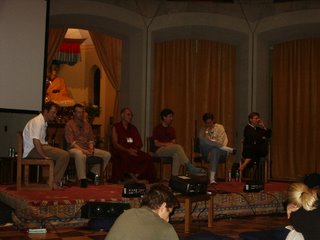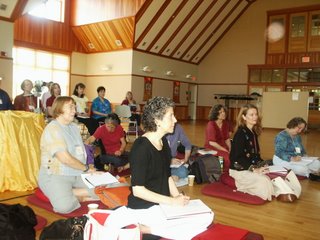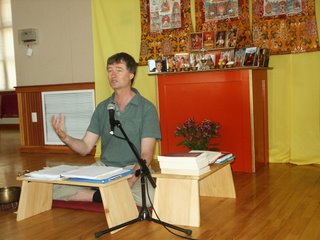
I Just returned from the Mind & Life Summer Research Institute 2006. It was an amazing gathering of Buddhists and scientists and combinations of the two, on the beautiful grounds of the Garrison Institute in Garrison, NY. It is quite unique in that it is a combination of a scientific meeting and a retreat. The retreat began by watching a beautiful documentary about the life of Francisco Varela, who basically started this dialogue between Buddhism and science (the film is called What is Life?). He must have been a very noble being, a rare combination of a brilliant scientist and a beautiful practitioner. At this retreat, we started and ended every day with a solid meditation practice and optional yoga (taught by Jon Kabat-Zinn!). After breakfast we broke the noble silence that was in effect every evening after the meditation practice, and started to discuss theoretical frameworks for the study of contemplative practice, new exciting data, research proposals and difficult issues in this type of research. It was really exciting to be among so many bright and interesting people, and to develop ideas for studies together. at some point I even ended up in a multi-lab lab meeting where we developed a new paradigm that all the labs present were interested in using. A really very friendly and collaborative atmosphere. Yet it was also so incredibly silent - to just simply find the silence within that is always there.

We ended with a complete day of meditation, where we simply looked at our own minds, as if in a laboratory, a laboratory of introspection. This is really what the new discipline of contemplative neuroscience would be like: not only studying meditation or any contemplative practice from the outside, but also very much from the inside, acquiring the experience itself. In here we can very much develop the tools of neurophenomenology, as proposed by Francisco Varela and Evan Thompson. We not only talked about introducing experience or the first person perspective in neuroscience and the study of consciousness, but about lots of other things as well, leading from attention and mind-wandering (discussed by Jonathan Schooler, who developed tools to measure mind-wandering) to emotion regulation and Mindfulness Based Stress Reduction as treatment for diseases like fibromalgyia or depression. Moreover, we even learnt about Christian forms of contemplation: (centering prayer and taxonomies of meditation that are starting to be developed. And finally, this summer institute was an amazing network, or mandala that has been developed of scientists who start collaborations all over - what an amazing coming together of circumstances!


